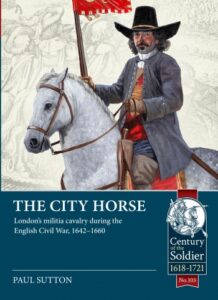Published May 2023
This book tells in detail the story of the City Horse, the militia cavalry from London, that served in the Parliamentary armies between 1642 and 1660.
They defended the capital in November 1642 when Charles I attempted to enter London and then provided a guard of honour for his son when he did enter the city eighteen years later. They scrambled through the breach when Winchester was stormed in 1642, they participated in the relief of Gloucester in 1643 and the disaster in Cornwall in 1644. They fought at both battles of Newbury (1643 & 1644), at Cheriton (1644) and even at far way Worcester (1651). Elements had attempted a surprise attack on Basing House in 1643 whilst others successfully stormed Shelford Manor in 1645. They raided the Royalist outposts around Oxford from their base at Abingdon throughout 1645 but were also themselves raided and bloodied by none other than Prince Rupert himself at Olney in 1643. Some of these Londoners might have come close to mutiny in late 1645 when they returned to the capital without orders whilst others refused to serve under Sir William Waller in 1644. Very few military formations before the creation of the New Model Army can boast the longevity of service that both the militia cavalry, or their infantry comrades in the London Trained Bands could, and so it is pertinent to ask just how effective the City Horse were and what legacy remains of their service.
These units were militia, part-time soldiers, who were mobilised as military necessity dictated. That year the London militia cavalry were in constant service, a reminder of how dire the Parliamentary cause still was, and these civilians endured much hardship, with many losing their lives, as they served in the main field armies across southern England. In fact, they had been serving since the autumn of 1642, from the beginning of the conflict, and were to remain in service, in differing forms, until the political upheaval known to history as the English Revolution came to a conclusion in May 1660 with the restoration of monarchy. The aim of this book is to document and illustrate the formation, organisation, deployment, equipping, and financing of these various London militia cavalry units, commonly referred to as the City Horse, during this period. A particular emphasis has been placed throughout the book on the relationship between the City Horse and the political/military events of the day, illustrating how these events influenced both the raising and deployment of these various units of cavalry. The City Horse, for the purposes of this book, are defined as units of cavalry recruited at the behest and control of the government of the City of London and not the units of regular cavalry raised by Parliament within the confines of London and surrounding areas. The difference is subtle but important. They were never intended to be full time units (though some became so) for they were envisaged to consist of citizen volunteers, deployed for a specific purpose for a limited duration. These City Horse units included the individual troops raised within the City at the end of 1642, which were regimented shortly afterwards and that served, with the permission of the City’s Militia Committee, in the field armies of Parliament throughout the First Civil War. They also include the supernumerary, volunteer and reformado cavalry raised in the City during the heady summer of 1647, as well as those forces constituted by the various Commonwealth and Protectorate governments in their attempts to settle the national militia prior to the Restoration of Charles II in 1660.

